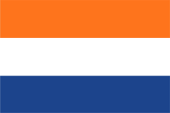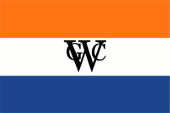|
|
| Übersicht – Contents: | |
|
|
| Übersicht – Contents: | |
Flaggen – Flags: |
|
 |
1624–1667, Flagge der Niederlande – Flag of the Netherlands, Seitenverhältnis – ratio = 2:3, Quelle/Source: Flaggen Enzyklopädie |
 |
1621–1660, Flagge der Niederländischen Westindien-Kompanie – flag of the Dutch West India Company, Seitenverhältnis – ratio = 2:3, Quelle/Source: Wikipedia (NL) |
|
|
|
| Die im Jahre 1621 gegründete Kolonie Neu-Niederlande wurde durch die Niederländische Westindien-Kompanie angelegt. Deren Flagge zeigte die niederländischen Farben der damaligen Zeit, drei waagerechte Streifen in Orange, Weiß und Blau, wobei der weiße Streifen in der Mitte um die Initialen GWC ergänzt wurde. Sie stehen für "Geoctroyeerde West-Indische Compagnie". In der Kolonie selber wurde die damalige Flagge der Niederlande verwendet, drei waagerechte Streifen in Orange, Weiß und Blau. Um 1660 herum begann der Prozess der Umstellung auf die heutigen Farben der Niederlande: Rot, Weiß und Blau, der sich Jahre hinzog und erst 1796 mit deren offiziellen Einführung abgeschlosssen war. | The in
1621 founded Colony of New Netherlands was created by the Dutch West India
Company. Its flag showed the Dutch colours of that times, three horizontal
stripes in orange, white and blue, and the white stripe was added in the
middle by the initials GWC. They stand for "Geoctroyeerde West India
Company". In the colony itself, the then flag of the Netherlands was used, three horizontal stripes of orange, white and blue. Around 1660, the process of switching to today's colors of the Netherlands red, white and blue began, which lasted for years and was not fully completed until 1796 with the official introduction. |
| Quelle/Source: Volker Preuß, Flaggen Enzyklopädie | |
|
|
|
| Landkarte von Neu-Niederlande – Map of New Netherland: |
|
|
| Quelle/Source: Freeware, University of Texas Libraries, modyfied by: Volker Preuß |
|
|
| Zahlen und Fakten – Numbers and Facts: | |
|
|
|
|
|
|
|
|
|
|
|
|
| ca. 7000
v.Chr. · Besiedlung durch Indianer (Lenni Lenape) 1496 · der englische Seefahrer John Cabot erkundet die Küste 16. Jhd. · spanische, portugiesische und französische Seefahrer erreichen die Küste 1609 · der englische Seefahrer Henry Hudson entdeckt die Halbinsel Manhattan 1614 · Gründung von Fort Nassau, der ersten Niederländischen Siedlung 1621 · Gründung der niederländischen Kolonie Neu-Niederlande 1626 · Gründung von Neu Amsterdam (heute Neu York) 1630 · die Niederländer errichten Fort Zwaanendael, die heutige Stadt Lewes 1631 · Fort Zwaanendael wird von den Indianern zerstört März 1638 · die Schweden errichten Fort Christiana, die heutige Stadt Wilmington 1651 · die Niederländer errichten Fort Casimir, die heutige Stadt New Castle 1654 · die Schweden erobern Fort Casimir 1655 · die Niederländer erobern Neuschweden und gliedern es als Neu-Amstel ihrer Kolonie Neu-Niederlande an 1664 · die Briten erobern Neu-Niederlande und gliedern es ihrer Kolonie Neu York an 1667 · Frieden von Breda, im Tausch gegen die Kolonie Neu Amsterdam (Neu York) erhält die Niederländische Westindien-Kompanie Surinam und Britisch-Guyana von England 1673–1674 · die Niederländer erobern Neu-Niederlande kurzzeitig zurück 1674 · die Stadt wird im Frieden von Westminster offiziell von den Niederlanden abgetreten |
|
|
| about
7000 B.C. · settlement by Indians (Lenni Lenape) 1496 · the English seafarer John Cabot explores the coast 16th century · Spanish, Portuguese and French navigators reach the coast 1609 · the English seafarer Henry Hudson discovers Manhattan Peninsula 1614 · founding of Fort Nassau, the first Dutch settlement 1621 · founding of the Dutch colony New Netherlands 1624 · founding of New Amsterdam 1626 · founding of New Amsterdam (now New York) 1630 · the Dutch built Fort Zwaanendael, the present town of Lewes 1631 · Fort Zwaanendael is destroyed by the Indians March 1638 · the Swedes built Fort Christiana, the present city of Wilmington 1651 · the Dutch built Fort Casimir, now the city of New Castle 1654 · the Swedes capture Fort Casimir 1655 · the Dutch conquer New Sweden, and annex it as New Amstel to their colony of New Netherland 1664 · the British conquer New Netherland and annex it to their colony of New York 1667 · Peace of Breda, in exchange for the colony of New Amsterdam (New York), the Dutch West India Company receives Suriname and British Guiana from England 1673–1674 · the Dutch conquer New Netherlands temporarily back 1674 · the Netherlands cede the city officially in the Peace of Westminster |
| Quelle/Source: Weltgeschichte, Wikipedia (DE) |
|
|
| Der Name "Neuniederland" geht auf den Namen eines der ersten Schiffe zurück, die Kolonisten in das Land brachten. Die offizielle Bezeichnung für das Land war: "Novi Belgii Novæque Angliæ", kurz "Nova Belgica" oder "Novum Belgium", also "Neu Belgica". Er sollte an die frühere Römische Provinz Belgica erinnern. | The name "New Netherland" goes back to the name of one of the first ships that brought colonists to the country. The official name for the country was: "Novi Belgii Novæque Angliæ", or "Nova Belgica" or "Novum Belgium", that means "New Belgica". It should remember the former Roman province of Belgica. |
| Quelle/Source: Wikipedia (DE), Volker Preuß | |
|
|
|